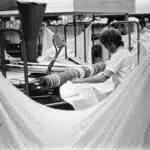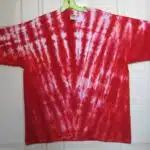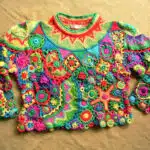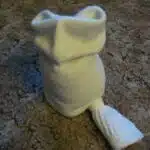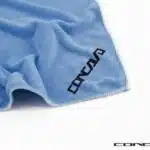As a laundry and folding expert, I have encountered numerous clients who struggle with the task of folding clothes, sheets, and towels. Properly folded linens create an organized and visually appealing storage space, making it easier to find what you need when you need it. The proper technique for folding various types of linens can also extend their lifespan by reducing wear and tear over time.
In this article, I will provide detailed instructions on how to fold all kinds of clothes, sheets, and towels. Whether you’re a seasoned pro or a novice in the art of laundry folding, these techniques will help you achieve crisp edges and uniform folds every time. With my guidance, you’ll be able to tackle your linen closet with confidence and ease, leaving you more time to focus on other areas of your household responsibilities.
Folding Basic T-Shirts
As a laundry and folding expert, I understand the importance of utilizing different folding techniques for various types of clothes. When it comes to basic t-shirts, there are several methods that are proven to be effective. The first technique is the classic fold, which involves folding the shirt in half vertically and then horizontally. This results in a neat square shape that can be easily stacked or stored.
Another popular method is the military roll, which is commonly used by soldiers to maximize space in their backpacks. This technique involves laying the shirt flat on a surface and then folding both sides towards the center. Next, roll the shirt tightly from the bottom up until it reaches the collar. This method not only saves space but also prevents wrinkles.
When it comes to materials for t-shirt folding, it’s best to use a clean and flat surface such as a table or counter. Avoid using uneven surfaces as this can result in uneven folds. Additionally, make sure your hands are clean and dry to prevent any dirt or moisture from transferring onto your clothes. By utilizing these techniques and materials, you can ensure that your basic t-shirts remain organized and wrinkle-free. Moving forward, let’s explore how to properly fold button-up shirts without compromising their structure or style.
Folding Button-Up Shirts
When it comes to folding button-up shirts, there are a few techniques that can help you achieve the best results. The first step is to lay the shirt flat on a surface with the buttons facing down. Smooth out any wrinkles or creases by running your hands over the surface of the shirt.
Next, fold one side of the shirt towards the center, making sure to line up the sleeve and shoulder seams. Repeat this on the other side so that both sides meet in the middle. Then, fold the bottom of the shirt up towards the collar, creating a straight edge at the bottom.
To avoid wrinkles when folding button-up shirts, it’s important to handle them gently and avoid over-folding or creasing. Make sure to smooth out any wrinkles before beginning to fold and use a flat surface for folding. Additionally, you can try using fabric softener or dryer sheets in your laundry routine to help keep shirts looking fresh and wrinkle-free.
Transition: Now that you’ve mastered folding button-up shirts, let’s move onto another type of clothing – sweaters and sweatshirts. These items require a slightly different approach due to their bulkier material, but with some simple tips and tricks, you’ll be able to fold them like a pro in no time.
Folding Sweaters And Sweatshirts
After mastering the art of folding button-up shirts, you are now ready to move on to more challenging items. Don’t worry; it’s not as complicated as it may seem. With different folding techniques and a bit of patience, you can fold sweaters and sweatshirts like a pro in no time.
When it comes to folding sweaters and sweatshirts, the best materials for folding are surfaces that prevent snagging or stretching. Opt for a smooth surface such as a table or countertop that has been covered with a clean towel or sheet. It’s also essential to ensure that the sweater is completely dry before attempting to fold it.
Now, let’s dive into the different folding techniques for sweaters and sweatshirts. First, lay your sweater flat on the smooth surface with the sleeves spread out evenly at both sides. Next, fold each side of the sweater towards the center so that they meet in the middle. Fold again from the bottom up, until you have a neat rectangle shape. For sweatshirts, follow these same steps but make sure to fold them in half lengthwise first before proceeding with the next folds.
As you become more confident in your folding skills, it’s time to tackle jeans and pants. But don’t worry; we’ll show you how easy it is in our next section!
Folding Jeans And Pants
Folding jeans and pants can be a breeze if you know the right folding techniques. These space-saving techniques are essential for anyone looking to optimize their closet space. The first step in folding jeans and pants is to ensure that they are clean and dry.
When it comes to folding techniques for different fabrics, you need to consider the thickness of the material. For example, denim is thicker than cotton, which means that it will require more effort to fold neatly. To begin, lay your jeans or pants flat on a surface such as a table or bed. Fold one leg in towards the center of the garment, then repeat with the other leg. Next, bring up the bottom of the pants so that it meets with the waistband. Finally, fold the waistband down towards the bottom of the pants.
By using these space-saving techniques and folding techniques for different fabrics, you can optimize your closet space while keeping your clothes organized and wrinkle-free. In addition, these methods make it easier to find what you’re looking for when getting dressed in a hurry. Now that you know how to fold jeans and pants properly, let’s move onto folding dresses and skirts for even more wardrobe organization tips.
Folding Dresses And Skirts
- Straight skirts can be neatly folded by laying them flat on a surface and ensuring the waistband is in the centre.
- Pleated skirts should be folded vertically along the pleats and then again horizontally in half.
- Dresses should be turned inside out and folded in half vertically with the shoulder straps tucked in.
- For best results, skirts and dresses should be folded in small sections to ensure neatness and to minimise creases.
- Towels can be folded by stacking them first and then folding them in half lengthwise and widthwise.
- Sheets should be folded by aligning the long edges and then folding in half lengthwise twice and widthwise twice.
Folding Straight Skirts
Folding straight skirts may seem like a simple task, but it is essential to ensure that the garment looks neat and tidy. To begin, lay the skirt flat on a surface, ensuring that it is wrinkle-free. Fold the skirt in half lengthwise so that the hemline meets the waistband. Smooth out any wrinkles and adjust any seams that are not aligned.
Next, fold the skirt in half again so that the waistband meets the hemline. This will create a compact bundle that can be easily stored or displayed. If you want to add accessories, such as a belt or scarf, place them on top of the folded skirt before making the final fold.
Finally, if you plan to display your folded skirts creatively, consider using a clothes hanger or arranging them in a decorative basket or shelf. This will not only keep them organized but also add visual appeal to your storage space. With these simple steps, folding straight skirts will become second nature and help maintain an organized wardrobe.
Folding Pleated Skirts
Folding dresses and skirts is an essential part of maintaining an organized wardrobe. While folding straight skirts may be a straightforward task, creating pleats can be more challenging. To create pleats, start by laying the skirt flat on a surface and smoothing out any wrinkles. Then, take the fabric in small sections and fold it back on itself, creating a zig-zag pattern. Repeat this process until all sections of the skirt are pleated.
Once you have created pleats in your skirt, it is important to store it properly to avoid crushing or flattening the pleats. The best way to store pleated items is by hanging them up using a padded hanger or storing them flat in a drawer with tissue paper between each fold. Avoid stacking pleated items on top of one another as this can cause the pleats to flatten over time.
Folding pleated skirts may require more effort than folding straight skirts, but with these simple steps, you can ensure that your garments stay neat and tidy while also preserving their unique design. By taking care when folding and storing your dresses and skirts, you can enjoy them for years to come.
Folding Dresses
Folding dresses is an art that requires attention to detail. Different techniques can be used, depending on the type of dress and fabric. A-line dresses, for example, can be folded in half lengthwise before folding them again into thirds or quarters. Meanwhile, shirt dresses may require a different approach by folding the sleeves and collar inward first before bringing the hem up to meet them.
When it comes to fabrics that are best suited for folding, lightweight and non-bulky materials such as cotton, linen, and silk are ideal. These fabrics are less likely to wrinkle or crease during the folding process while still maintaining their shape and texture. However, it is important to note that heavily embellished or structured dresses may not be suitable for folding as they may lose their shape over time.
To properly fold a dress, start by laying it flat on a surface with any zippers or buttons fastened. Smooth out any wrinkles before beginning the folding process. Depending on the style of the dress, you may need to fold it in half lengthwise or bring the hem up towards the neckline. Always make sure that each fold is neat and straight before moving onto the next one. By mastering these techniques and selecting appropriate fabrics, you can ensure that your dresses stay organized and wrinkle-free for years to come.
Folding Undergarments
Have you ever struggled with folding your undergarments neatly? Fear not, as it is a common problem that can be easily solved. Properly folding your undergarments can not only make them easier to store and find in your dresser or closet but also extend their lifespan.
To begin, start by organizing your drawer before you fold your undergarments. Remove everything inside and wipe down the bottom of the drawer with a damp cloth. Next, sort through each pair of undergarments and get rid of any that are old, worn out, or no longer fit properly. This will help maximize space and ensure that you only keep what you need.
When it comes to folding your undergarments, there are a few key tips to keep in mind. First, lay each piece flat on top of each other and smooth out any wrinkles or creases. Then, fold them vertically into thirds so they are in long rectangular shapes. Lastly, fold them horizontally into thirds again so they are now small squares that can easily be stored in your drawer or travel bag.
Remember these three tips when folding your undergarments – organize your drawer first, lay each piece flat and smooth out wrinkles, and fold vertically then horizontally into thirds. By following these steps, not only will you have neatly folded undergarments but also an organized dresser or closet maximizing space for all of your clothing needs! Next up: let’s tackle how to properly fold socks without losing their matching pairs.
Folding Socks
Folding socks can be a tedious task, but it is essential to keep them organized and easy to find when you need them. Different techniques can be used to fold socks according to your preference. One of the most popular ways is folding them in half with the toes touching each other and then rolling them up from the ankle towards the opening. This technique saves space and keeps your socks neat.
Sorting socks before folding them will help you save time and avoid any mismatched pairs. The easiest way to sort your socks is by color or pattern, but you can also sort them by size or purpose, such as sports socks or dress socks. By sorting beforehand, you will know exactly what you have and where it is.
Remember that folding socks should not be rushed. Take the time to go through each pair carefully and ensure that they are neatly folded. With these techniques, you will be able to keep your sock drawer organized and make finding a matching pair a breeze.
Transition: Now that we have mastered the art of folding socks, let’s move on to another essential item in our laundry routine – bath towels.
Folding Bath Towels
As a laundry and folding expert, I understand the importance of having neat and organized towels in your home. Bath towels are an essential part of any household, but they can take up a lot of space if not folded correctly. Different towel folding techniques can help you maximize your storage space while still maintaining an aesthetically pleasing look.
One popular way to fold bath towels is by creating a square shape. Start by laying the towel flat on a clean surface with the longer end facing you. Fold the bottom third of the towel up towards the center, then fold the top third down towards the center as well. Finally, fold the towel in half horizontally to create a square shape that can easily fit into your linen closet or bathroom shelves.
If you’re short on space, try experimenting with towel folding for small spaces. One idea is to roll your bath towels instead of folding them. This technique allows you to save vertical space while also giving your towels a spa-like appearance. Simply fold one end of the towel down about 4 inches, then tightly roll it up from that end until you reach the other side of the towel. Secure it with ribbon or twine for an elegant touch.
Transitioning into our next section about folding hand towels, keep in mind that different types of towels require different folding techniques. While bath towels are often folded into squares or rolled up for small spaces, hand towels can be folded in creative ways to add personality and style to your bathroom decor.
Folding Hand Towels
Hand towels are a smaller version of bath towels, used for drying hands and face. Folding hand towels is an easy task that can be done in several ways such as rolling or folding them into decorative shapes. The choice of fold depends on your preference and the decor of your bathroom.
To fold a hand towel, first, lay it flat on a surface with its shorter side facing you. Then fold one-third of the towel towards the center. Next, fold the other side towards the center so that it overlaps slightly with the first fold. Finally, bring the bottom edge up to meet the top edge and smooth out any wrinkles or creases. This technique creates a classic rectangular fold perfect for stacking in a linen closet.
If you prefer a more decorative look, try creating different folds such as origami-inspired shapes or pleats. Hanging hand towels is also an option to consider if you have limited storage space or want to add some style to your powder room. Fold your hand towel in half lengthwise and then in half again so that it forms a loop. Hang it over a hook or bar where it will be easily accessible for guests or family members.
Moving on to washcloths, these small squares of fabric are used for cleaning faces and bodies during bathing. Stay tuned for our next section on how to efficiently fold washcloths and keep them organized in your linen closet!
Folding Washcloths
After mastering the art of folding hand towels, it’s time to move on to the next level of laundry-folding expertise: washcloths. Despite their small size, washcloths can be quite tricky to fold neatly. However, with a few simple tips and tricks, you can efficiently fold your washcloths like a pro.
Firstly, start by laying the washcloth flat on a surface. Fold each corner inwards towards the center, making sure that they overlap slightly. Then, take one end of the washcloth and fold it towards the center. Repeat this step with the other end of the washcloth so that both ends meet in the middle. Finally, fold the washcloth in half lengthwise and voila! You have a perfectly folded washcloth.
But why stop at just folding your washcloths? Get creative with how you use them in your home decor! Rolled up and placed in a basket or displayed on a shelf, neatly folded washcloths can add a touch of elegance to any bathroom or bedroom. Plus, having them readily available for guests is always a nice touch.
Now that you’ve mastered folding hand towels and washcloths, it’s time to tackle one of the most challenging items to fold: fitted sheets. But don’t worry – with our expert tips and tricks, you’ll be able to conquer even this laundry feat effortlessly.
Folding Fitted Sheets
- When folding fitted sheets, it’s important to first fold the corners of the sheet up and in so that the elastic is held in place.
- The next step is to roll the fitted sheet from the corners up, creating a neat and compact log-like shape.
- This same technique can be used to fold blankets and towels, as well as other linens, as it helps create a more efficient and organized look.
- By following these simple steps, you can ensure that your laundry and folding experience will be a successful one.
Folding Corners
Mastering corners is a crucial aspect of folding fitted sheets. To achieve the perfect fold, it is essential to understand how to tackle the corners. Creative folding techniques can make all the difference in achieving a neat and tidy look.
To start, lay your fitted sheet flat on a surface with the elastic side facing up. Reach into one corner and grab both the top and bottom layers of fabric. Pull them up and over to create a pocket-like shape. Then, tuck in the excess fabric from the sides before smoothing out any wrinkles. Repeat this process for all four corners.
One creative technique for mastering corners involves using your own body as a tool. After creating pockets with each corner, hold two adjacent corners in one hand while sliding your other hand down the edge of the sheet. This will cause the sheet to fold into thirds, making it easier to finish off with a neat fold. With these tips and tricks, you’ll be able to fold fitted sheets like a pro!
Rolling Sheets
When it comes to folding fitted sheets, the process can be tricky and time-consuming. However, mastering this skill is essential for maintaining organization in your linen closet. While folding may be the most common way of storing sheets, rolling them is also a great alternative. Rolling sheets not only saves space but also helps prevent wrinkles.
To roll sheets without wrinkles, start by laying your sheet flat on a surface with the elastic side facing down. Smooth out any wrinkles or creases before grabbing one corner of the sheet and pulling it up towards the opposite corner. Then, repeat this process for the other two corners until you have a triangle-shaped sheet. From there, begin rolling the sheet tightly from one end to the other until you reach the other end.
Tips for storing rolled sheets to save space include placing them in clear plastic bags with labels indicating their size and type of bedding. Another option is to place them inside pillowcases or fabric storage bins. Storing sheets properly not only keeps them organized but also helps preserve their quality over time.
In conclusion, while folding may be the traditional way of storing sheets, rolling can provide many benefits such as saving space and preventing wrinkles. By following these simple steps and tips for storage, you’ll be able to master both folding and rolling fitted sheets like an expert laundry professional.
Folding Flat Sheets
Folding flat sheets requires some basic techniques to ensure that the final product is neat and tidy. Start by laying the sheet flat on a table or bed, with the hemmed edges facing down. Smooth out any wrinkles or creases by running your hands over the surface of the sheet. Fold in half lengthwise, matching up the corners and edges as closely as possible.
Next, fold the sheet in half again, this time matching up the top and bottom hemmed edges. Ensure that all four corners are aligned neatly before folding. The resulting rectangular shape should be roughly one-quarter of the original size of the sheet.
Finally, fold the rectangle into thirds, making sure that all edges are neatly aligned and smooth. This will result in a compact, easy-to-store bundle that can be placed in a linen closet or drawer. For larger sheets, it may be helpful to use a folding board or table to create crisp edges and perfect folds.
To take your linen organization to the next level, consider incorporating tips for organizing linen closets into your routine. This could include sorting linens by size or color, using labeled storage bins or baskets, and regularly purging items that are no longer needed or used. By keeping your linens neat and organized, you’ll save time searching for specific items and ensure that everything is always fresh and ready for use.
Moving on from folding flat sheets, let’s explore how to fold a fitted sheet – another laundry challenge many of us face on a regular basis. But don’t worry – with a few simple steps and some practice, you’ll be able to master this task just like folding flat sheets and organizing your linen closet.
Folding Pillowcases
As the saying goes, “a well-folded pillowcase is a happy pillowcase.” Pillowcases can often be overlooked when it comes to folding, but taking the time to properly fold them will not only make your linen closet look neater, but also prolong the life of your pillowcases.
Start by laying the pillowcase flat on a surface with the opening facing away from you. Fold one corner inwards towards the center of the pillowcase, then repeat with the opposite corner. Take one of the newly formed corners and fold it towards the center once more, creating a pointed edge. Repeat with the other corner so that both edges meet in the middle. Finally, fold in half or thirds depending on your preferred method of storage.
When it comes to decorative pillows, folding can be a bit trickier. Begin by fluffing up and smoothing out any wrinkles or creases in the fabric. Then, take both ends of the pillow and bring them together so that they overlap slightly in the middle. Fold one end over onto itself about 1/3 of its length and repeat with the other end. Finally, tuck any loose fabric underneath to create a neat rectangular shape.
Properly folded linens can make all the difference when it comes to maximizing space and keeping everything organized. To ensure that your linens stay fresh and wrinkle-free while in storage, consider investing in some storage solutions such as vacuum-sealed bags or labeled bins for easy access. By taking care when folding your linens and storing them properly, you’ll be able to enjoy cozy nights’ sleep for years to come!
Storing Linens Properly
When it comes to storing linens properly, there are many organizing tips that can be useful. One of the most important things to keep in mind is to create a designated space for your linen closet. This will help you to stay organized and ensure that everything has its place. Consider investing in shelving or storage containers to make the most of your space.
When folding and storing your linens, it’s important to consider how they will be used. For example, sheets should be folded neatly and stored together by size. Towels can be rolled or folded depending on your preference, but make sure they are stacked neatly and separated by type (e.g., bath towels vs hand towels). Additionally, consider adding labels or color coding items to make it easier to find what you need quickly.
If you’re looking for a more drastic change, consider a linen closet makeover. This might include revamping the layout or adding additional storage options such as hanging organizers. By taking the time to assess your needs and preferences, you can create a linen closet that is both functional and aesthetically pleasing. Remember that organization is key when it comes to storing linens, so take the time to plan out your space carefully before getting started.
| Linen Type | Folding Technique | Storage Method |
|---|---|---|
| Sheets | Fold neatly in half twice | Store together by size |
| Towels | Roll or fold depending on preference | Stack neatly and separate by type |
| Blankets/Quilts | Fold neatly into thirds or quarters | Store on shelves or in vacuum-sealed bags |
With these organizing tips in mind, you’ll be well on your way to creating a beautifully arranged linen closet that will make finding what you need a breeze. However, even with careful planning and execution, sometimes issues may arise during the folding process. In the next section, we’ll explore some common troubleshooting techniques for those frustrating folding mishaps.
Troubleshooting Common Folding Issues
Storing linens properly is essential to maintain their quality and longevity. However, even when stored correctly, there may be issues with the folding process. Common mistakes include uneven edges, wrinkled fabric, and improper sizing. These issues can be frustrating for those who want to keep their linens looking neat and tidy.
Efficient techniques can help solve these common folding issues. One technique is to use a flat surface such as a table or bed and smooth out any wrinkles before folding. Another technique is to fold items in thirds rather than halves, which can help eliminate uneven edges. It’s also important to properly size the folds according to the item’s dimensions.
To further assist in achieving optimal folding results, consider the following nested bullet point list:
- Basic Folding Techniques
- Fold sheets in thirds lengthwise before folding in half.
- Fold fitted sheets by tucking corners into each other and then folding.
- Fold towels in thirds lengthwise before folding in half.
- Advanced Folding Techniques
- Create a hospital corner when making the bed for a more polished look.
- Use garment clips when hanging towels to avoid stretching.
By utilizing efficient techniques and avoiding common mistakes, anyone can achieve perfectly folded linens every time. With a little practice and attention to detail, you’ll have beautifully organized linen closets that are both functional and visually appealing.
Conclusion
As a laundry and folding expert, I believe that knowing how to properly fold different types of clothes, sheets, and towels is essential in maintaining their quality and appearance. Whether it’s a basic t-shirt or an elegant dress, each clothing item has its own specific folding technique.
By following the guidelines provided in this article, you will learn how to fold various items of clothing, including button-up shirts, sweaters, jeans, skirts, and more. Additionally, you will discover the best ways to fold flat sheets and pillowcases for easy storage. Properly storing linens is also discussed as it can greatly impact their lifespan.
In summary, proper folding techniques are crucial in maintaining the quality of your clothes and linens. By mastering these skills you can keep your wardrobe looking neat and tidy while preserving the longevity of your favorite pieces. Remember to pay attention to small details during the folding process to ensure that everything looks perfect every time you pull them out of your closet or linen cupboard.
Image Credits




